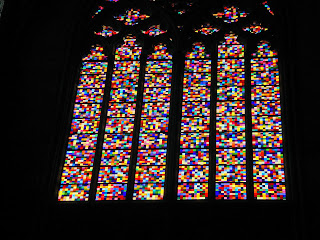 For over half a century after the end of World War II, the massive south window of the spectacular Gothic cathedral in Cologne, Germany was simple glass, the original stained glass having been destroyed, like most of the rest of the city, in allied bombing raids. Finally, in 2007, it got a new stained glass window designed by the German artist Gerhard Richter: a spectacular series of what look to be pixels; 11,500 individual squares in 72 different colors. The overall effect, seen below close up and a bit farther out, is stunning.
For over half a century after the end of World War II, the massive south window of the spectacular Gothic cathedral in Cologne, Germany was simple glass, the original stained glass having been destroyed, like most of the rest of the city, in allied bombing raids. Finally, in 2007, it got a new stained glass window designed by the German artist Gerhard Richter: a spectacular series of what look to be pixels; 11,500 individual squares in 72 different colors. The overall effect, seen below close up and a bit farther out, is stunning.
The project, in addition to being beautiful (I can only imagine how the window looks when struck by direct sunlight) also goes a long way towards defining my particular thoughts on architecture and urban design. The way to respect the past, in a building or a city, is not to mindlessly ape it or put every "historical" building or district on a pedestal. When we do that with a city or a landmark, we draw a line in sands that are always going to be shifting. The Cologne Cathedral is a perfect example of this in more ways than one: begun in 1248, it was not finally completed until 1880. It is still, rightly, seen as one of the crowning achievements of Gothic architecture, but it is not a medieval church. It was the product of 600 (now almost 800) years of evolution and change.

A city is, or ought to be, like that. It is always changing and always in flux and while, for one reason or another, certain buildings are worthy of at least temporary protection, to take an entire neighborhood or district of a major city and declare it a protected historical zone is to kill what makes it human. It has the added downfall of making it less interesting. Wandering around the City of London (the small legal entity, not the massive metropolitan area) is striking because you turn the corner of a narrow, winding medieval street and see an ancient church next to a glass and steel office tower. This is a contrast that respects history by respecting the present, doing to London what people have always done to London: building, changing some things, keeping some other things around, in a wonderfully hodge-podge way. This, despite calls from some church officials for figurative representations of 20th century martyrs, is what Gerhard Richter and the archdiocese of Cologne did with this window. Good for them and good for us.
No comments:
Post a Comment